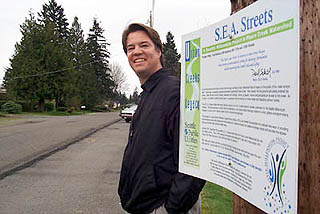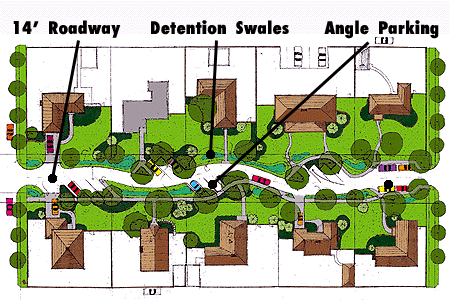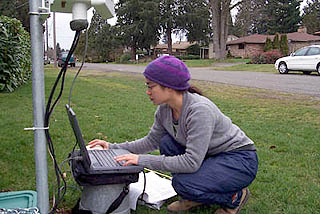|
Subscribe / Renew |
|
|
Contact Us |
|
| ► Subscribe to our Free Weekly Newsletter | |
| home | Welcome, sign in or click here to subscribe. | login |
News
| |
March 6, 2000
Green building takes to the streets
Journal Staff Reporter
It's not every day that a project breezes through the Seattle Design Commission.
But at last week's session, Design Commission members had mostly glowing things to say about a green-street proposal for a block on Second Avenue Northwest at North 117th Street.
"The commission does its best work in one-block segments," joked commission chair Rick Sundberg. "We look forward to seeing first implementation of this."

|
The pilot project will be used as a model to show how impervious surfaces can be reduced and peak stormwater flows controlled. Construction will begin in June and be complete by August.
SPU will sponsor an open house to discuss the project from 7 to 9 p.m. March 8 at Broadview-Thomson Elementary School, 13052 Greenwood Ave. N.
The 650-foot continuous block runs between North 117th and 120th. The area was chosen for the pilot project because it has no street improvements or drainage system. The SEA project will reduce the width of the street from 20 feet to 14 feet and add six swales on each side of the street, as well as a sidewalk on the west side and 80 to 100 trees. The swales channel water and will be connected by 12 culverts that feed into the existing ditch and culvert system on 117th.
The SEA system, according to project manager John Arnesen, will reduce peak flow volumes and increase soil infiltration. Reducing stormwater volumes is a crucial step in minimizing creek erosion and flooding. Stormwater from the neighborhood flows into Pipers Creek, and eventually into Puget Sound.
With an estimated design and construction cost of $700,000 to $800,000, it's not clear whether the city will fund additional projects or whether other interested neighborhoods would have to pay for similar improvements, Arnesen said.
"If it happens on a large scale, it's most likely going to involve property owner contributions," Arnesen said.

|
The swale system is essential to improving the upper watershed flow volumes and creating a more even flow system through creeks, Arnesen said. Detaining water in the swales accomplishes that goal.
"Swales take the peak off the storm," he said. "The flow is more constant and over a longer period of time."
Reducing impervious areas by narrowing the street will also minimize flows, he said.
The proposal received overwhelming approval from residents on Second Avenue North. In exchange for an improved stormwater system, residents will use on-street, diagonal parking areas to make space for planting more vegetation and trees.
The street will also be curved, which some observers see as a welcome change from the grid system.

|
Arnesen said the pilot project could also serve as a model for new residential developments. If the first SEA project is a success, architect Rick Sundberg said the city should develop an overall urban design master plan showing where other SEA projects would be most useful.
Architect Nora Jaso called the green street a "bold change that has many implications. The big question in my mind is if this is just a one-shot deal or is it going to have long-term ramifications?"
At the design commission meeting, Cipriani called SEA "the most commendable project I've seen since I've been on the commission. It has potential from an environmental perspective, from a transportation perspective and from a community building perspective. We've got to find a way to make it flourish."


